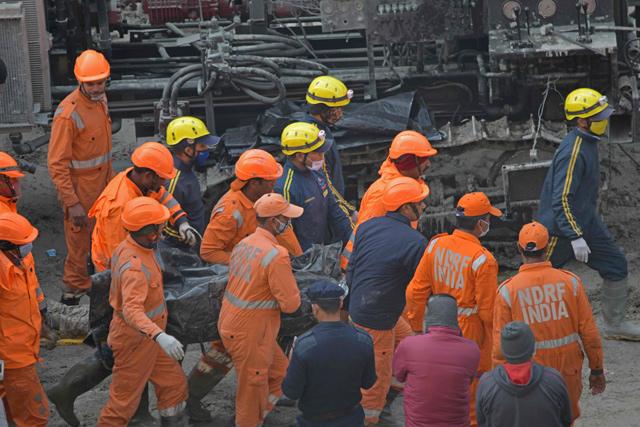You are here
Indian rescuers bring first workers out of tunnel after 17 days
By AFP - Nov 28,2023 - Last updated at Nov 28,2023

This handout photo released by Uttarakhand’s Department of Information and Public Relation (DIPR) and taken on Tuesday shows Chief Minister of Uttarakhand Pushkar Singh Dhami embracing a contruction worker (AFP photo)
SILKYARA TUNNEL, INDIA — Indian rescuers on Tuesday began bringing out the first of the 41 men trapped for 17 days behind tonnes of earth inside a Himalayan road tunnel after a marathon engineering operation to free them.
The rescued men were draped in orange marigold flower garlands in celebration as they were greeted by state officials, government photographs showed, with a line of ambulances waiting to receive them.
Crowds cheered as emergency vehicles with lights flashing readied to leave the tunnel entrance, where the workers had been trapped since a portion of the under-construction tunnel in the Himalayan state of Uttarakhand collapsed on November 12.
AFP reporters spoke to family members waiting at the site who confirmed the exhausted men had been freed, pulled out through 57 metres (187 feet) of steel pipe on stretchers specially fitted with wheels.
Uttarakhand state chief minister Pushkar Singh Dhami said the “work of evacuating the workers has begun”, confirming eight had been freed, with rescuers working rapidly to bring more out.
“An initial health checkup of all the workers is being done in the temporary medical camp built in the tunnel,” Dhami said.
Rescue officials warned that once the first worker is brought out, it could still take several hours for all to escape.
‘Thankful to God’
Relatives outside had already begun celebrating even before the first man was pulled out.
“We are thankful to God and the rescuers who worked hard to save them,” Naiyer Ahmad told AFP, whose younger brother Sabah Ahmad is among the trapped workers, and who has been camping at the site for over two weeks.
Sudhansu Shah, who has also been camping out since shortly after the November 12 tunnel collapse waiting for his younger brother Sonu Shah, said relatives were relieved.
“We are really hopeful and happy,” he said.
Dhami praised the “prayers of tens of millions of countrymen and the tireless work of all the rescue teams engaged in the rescue operation”.
The health of the workers was “fine”, but a team of medics in a field hospital were ready on site as soon as they were brought out, he added.
Previous hopes of reaching the men were dashed by falling debris and the breakdown of multiple drilling machines, and the government warned multiple times of the “challenging Himalayan terrain”.
‘Effort and sacrifice’
After repeated setbacks in the operation, military engineers and skilled miners dug the final section by hand using a so-called “rat-hole” technique, a three-person team working at the rock face inside a metal pipe, just wide enough for someone to squeeze through.
Indian billionaire Anand Mahindra paid tribute to the men at the rockface who squeezed into the narrow pipe to clear the rocks by hand.
“After all the sophisticated drilling equipment, it’s the humble ‘rathole miners’ who make the vital breakthrough,” Mahindra said on X, formerly Twitter.
“It’s a heartwarming reminder that at the end of the day, heroism is most often a case of individual effort and sacrifice.”
Last week, engineers working to drive a metal pipe horizontally through the 57 metres of rock and concrete ran into metal girders and construction vehicles buried in the rubble, snapping a giant earth-boring machine.
A separate vertical shaft was also started from the forested hill above the tunnel, a risky route in an area that has already suffered a collapse.
Digging also took place from the far side of the road tunnel, a much longer third route estimated to be around 480 metres.
The workers were seen alive for the first time last week, peering into the lens of an endoscopic camera sent by rescuers down a thin pipe through which air, food, water and electricity were delivered.
The workers had plenty of space in the tunnel, with the area inside 8.5 metres high and stretching about two kilometres in length.
Arnold Dix, president of the International Tunnelling and Underground Space Association, who has been advising the engineers, told reporters ahead of the rescue that the men were in good spirits, and that he had heard they had been “playing cricket”.
Related Articles
SILKYARA TUNNEL INDIA — Ambulances were on standby Thursday morning as Indian rescuers dug through the final metres of debris separati
DEHRADUN, India — More than a hundred rescuers in northern India struggled for a third day on Tuesday to save dozens of workers trapped unde
TAPOVAN, India — Rescuers on Sunday pulled the first bodies from a blocked tunnel at a power complex in a northern Indian valley devastated

















